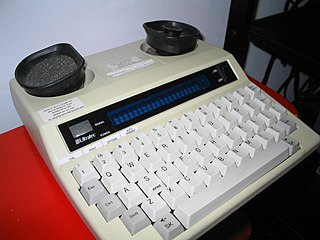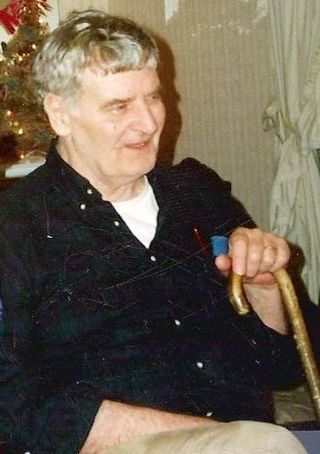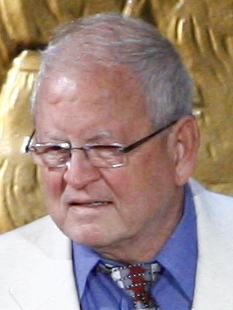The early history of radio is the history of technology that produces and uses radio instruments that use radio waves. Within the timeline of radio, many people contributed theory and inventions in what became radio. Radio development began as "wireless telegraphy". Later radio history increasingly involves matters of broadcasting.

In telecommunications, RS-232 or Recommended Standard 232 is a standard originally introduced in 1960 for serial communication transmission of data. It formally defines signals connecting between a DTE such as a computer terminal or PC, and a DCE, such as a modem. The standard defines the electrical characteristics and timing of signals, the meaning of signals, and the physical size and pinout of connectors. The current version of the standard is TIA-232-F Interface Between Data Terminal Equipment and Data Circuit-Terminating Equipment Employing Serial Binary Data Interchange, issued in 1997.

A telephone, colloquially referred to as a phone, is a telecommunications device that permits two or more users to conduct a conversation when they are too far apart to be easily heard directly. A telephone converts sound, typically and most efficiently the human voice, into electronic signals that are transmitted via cables and other communication channels to another telephone which reproduces the sound to the receiving user. The term is derived from Ancient Greek: τῆλε, romanized: tēle, lit. 'far' and φωνή, together meaning distant voice.

In telecommunications, an acoustic coupler is an interface device for coupling electrical signals by acoustical means—usually into and out of a telephone.
Data communication, including data transmission and data reception, is the transfer of data, transmitted and received over a point-to-point or point-to-multipoint communication channel. Examples of such channels are copper wires, optical fibers, wireless communication using radio spectrum, storage media and computer buses. The data are represented as an electromagnetic signal, such as an electrical voltage, radiowave, microwave, or infrared signal.

A telecommunications device for the deaf (TDD) is a teleprinter, an electronic device for text communication over a telephone line, that is designed for use by persons with hearing or speech difficulties. Other names for the device include teletypewriter (TTY), textphone, and minicom.

SRI International (SRI) is a United States-based nonprofit scientific research institute and organization headquartered in Menlo Park, California. It was established in 1946 by trustees of Stanford University to serve as a center of innovation to support economic development in the region.

A telecommunications relay service, also known as TRS, relay service, or IP-relay, or Web-based relay service, is an operator service that allows people who are deaf, hard of hearing, deafblind, or have a speech disorder to place calls to standard telephone users via a keyboard or assistive device. Originally, relay services were designed to be connected through a TDD, teletypewriter (TTY) or other assistive telephone device. Services gradually have expanded to include almost any real-time text capable technology such as a personal computer, laptop, mobile phone, PDA, and many other devices. The first TTY was invented by deaf scientist Robert Weitbrecht in 1964. The first relay service was established in 1974 by Converse Communications of Connecticut.

The Carterfone is a device invented by Thomas Carter. It connects a two-way radio system to the telephone system, allowing someone on the radio to talk to someone on the phone. This makes it a direct predecessor to today's autopatch. The connection is acoustic -- sound travels through the air between the Carterfone and a conventional telephone that is part of the telephone system.

106 Text Emergency Call, commonly known as simply 106, is the Australian national emergency telephone number to be used in life-threatening or time critical situations for those with a speech and / or hearing impairment who use telecommunications device for the deaf. It is run by the emergency telephone operator for the National Relay Service (NRS); formerly the Australian Communications Exchange (ACE), a non-profit organisation that provided the relay services component for the NRS. 106 can only be used by people with a TTY / textphone, or a computer with terminal software and a modem. 106 calls are given priority over other calls handled by the National Relay Service. 106 is a free-to-call number.

George H. Sweigert (1920–1999) is credited as the first inventor to patent the cordless telephone.

Telecommunications engineering is a subfield of electronics engineering which seeks to design and devise systems of communication at a distance. The work ranges from basic circuit design to strategic mass developments. A telecommunication engineer is responsible for designing and overseeing the installation of telecommunications equipment and facilities, such as complex electronic switching system, and other plain old telephone service facilities, optical fiber cabling, IP networks, and microwave transmission systems. Telecommunications engineering also overlaps with broadcast engineering.

A modulator-demodulator or most commonly referred to as modem is a computer hardware device that converts data from a digital format into a format suitable for an analog transmission medium such as telephone or radio. A modem transmits data by modulating one or more carrier wave signals to encode digital information, while the receiver demodulates the signal to recreate the original digital information. The goal is to produce a signal that can be transmitted easily and decoded reliably. Modems can be used with almost any means of transmitting analog signals, from light-emitting diodes to radio.
James Carlyle Marsters was a deaf orthodontist in Pasadena, California, who in 1964 helped invent the first teletypewriter device capable of being used with telephone lines. The device made communication by telephone possible for the deaf. Although Robert Weitbrecht did much of the actual design work, Marsters promoted the device's use.

Paul Taylor was an American engineer, a pioneer in development of telecommunications devices for the deaf. He also enjoyed a kind of celebrity status because of his central role in the award-winning documentary Hear and Now. The film by daughter Irene Taylor Brodsky chronicles the before and after experiences of her parents, Paul and Sally Taylor, both of whom underwent cochlear implant surgeries in their mid-60s after a lifetime of deafness.
Weitbrecht Communications, Inc. (WCI) is a Santa Monica, California company that specializes in providing products for deaf people. The company was founded as Applied Communications around 1965 by Robert Weitbrecht and James C. Marsters based on Weitbrecht's invention of the teleprinter at SRI International.
The Laurent Clerc Award is an annual honor bestowed by Gallaudet University's Alumni Association to recognize a deaf person for "his or her outstanding contributions to society," and specifically to honor their achievements in the interest of deaf people. It is named for Laurent Clerc (1785-1869). It has been given to notable scientists and inventors, such as deaf scientist Robert Weitbrecht, to honor his contributions in developing the teleprinter and an acoustic coupler for the early computer modem. It is awarded by Gallaudet University's Alumni Association through its Laurent Clerc Cultural Fund.

Anderson Jacobson, also known for a time as CXR Anderson Jacobson and today as CXR Networks, is a vendor of communications equipment. Anderson Jacobson was an early manufacturer of acoustic modems and was spun off from SRI International. In the 1970s and 1980s, the company manufactured modems, some intended for consumers. The company was acquired by CXR Telecom in 1988, at which time The Times was following Anderson Jacobson's earnings reports. The flow of new products continued.













